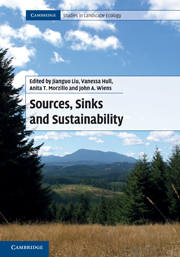Book contents
- Frontmatter
- Contents
- Contributors
- Preface
- Acknowledgments
- Part I Introduction
- Part II Advances in source–sink theory
- 2 Evolution in source–sink environments: implications for niche conservatism
- 3 Source–sink dynamics emerging from unstable ideal free habitat selection
- 4 Sources and sinks in the evolution and persistence of mutualisms
- 5 Effects of climate change on dynamics and stability of multiregional populations
- 6 Habitat quality, niche breadth, temporal stochasticity, and the persistence of populations in heterogeneous landscapes
- 7 When sinks rescue sources in dynamic environments
- 8 Sinks, sustainability, and conservation incentives
- Part III Progress in source–sink methodology
- Part IV Improvement of source–sink management
- Part V Synthesis
- Index
- References
7 - When sinks rescue sources in dynamic environments
Published online by Cambridge University Press: 05 July 2011
- Frontmatter
- Contents
- Contributors
- Preface
- Acknowledgments
- Part I Introduction
- Part II Advances in source–sink theory
- 2 Evolution in source–sink environments: implications for niche conservatism
- 3 Source–sink dynamics emerging from unstable ideal free habitat selection
- 4 Sources and sinks in the evolution and persistence of mutualisms
- 5 Effects of climate change on dynamics and stability of multiregional populations
- 6 Habitat quality, niche breadth, temporal stochasticity, and the persistence of populations in heterogeneous landscapes
- 7 When sinks rescue sources in dynamic environments
- 8 Sinks, sustainability, and conservation incentives
- Part III Progress in source–sink methodology
- Part IV Improvement of source–sink management
- Part V Synthesis
- Index
- References
Summary
Many species of conservation concern occur in spatially heterogeneous landscapes composed of different patches that function as population sources and population sinks. Temporal variation in habitat quality, due to a cycle of habitat disturbance and subsequent recovery, can create relatively underappreciated source–sink dynamics. A cycle of disturbance and recovery can cause a given patch to alternate between functioning as a population source and a population sink. During “good” years, this patch can conceivably sustain another nearby patch that is always sink habitat. However, after a disturbance, the putative source patch may then depend upon individuals from that sink for recolonization. Thus, the metapopulation can depend upon the presence of sink populations for long-term persistence, provided that the sink is relatively unaffected by disturbance. We developed a simple, two-patch model of source–sink dynamics in order to explore the sensitivity of long-term metapopulation persistence to the temporal scale of habitat disturbance, recovery in a putative source patch, and the rate of population decline in the sink. We found that management directed at decelerating the rate of population decline in the sink can have a much greater affect on metapopulation persistence than management targeted at increasing the rate of habitat recovery in the source. This result is magnified as disturbance frequency increases. It is hoped that sinks crucial to metapopulation survival are given appropriate conservation status.
- Type
- Chapter
- Information
- Sources, Sinks and Sustainability , pp. 139 - 154Publisher: Cambridge University PressPrint publication year: 2011
References
- 7
- Cited by

